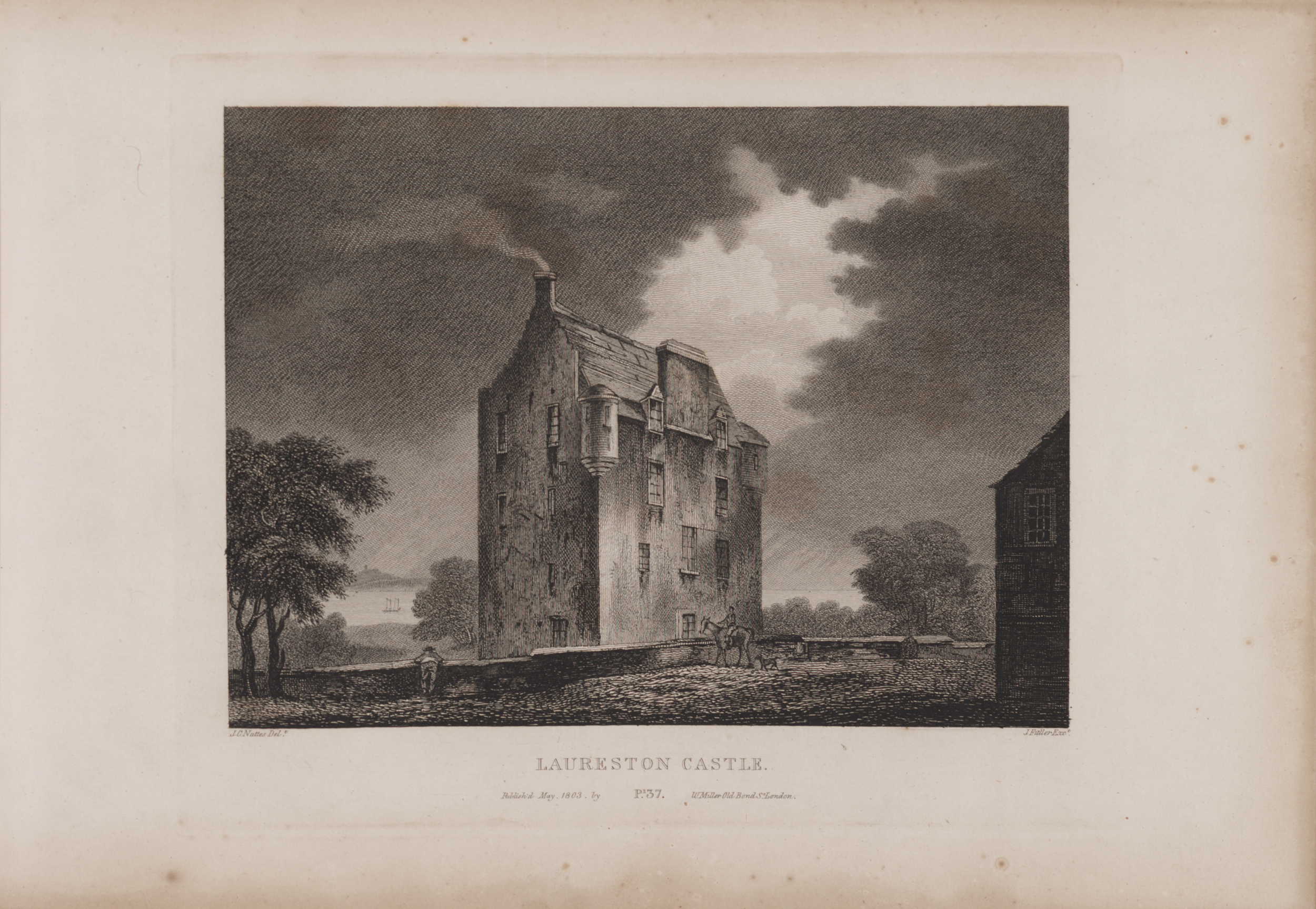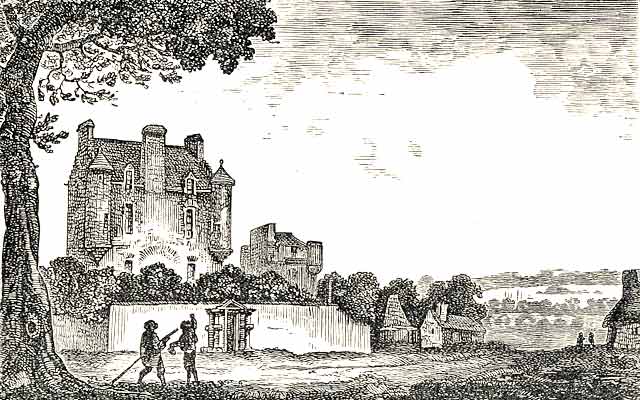Lauriston Castle on:
[Wikipedia]
[Google]
[Amazon]
Lauriston Castle is a 16th-century

 Lauriston Castle was originally a four-storey, stone L plan tower house, with a circular stair tower, with two-storey angle turrets complete with gun loops. A Jacobean range was added in 1827, to convert it to a country manor. This was designed by the prominent architect
Lauriston Castle was originally a four-storey, stone L plan tower house, with a circular stair tower, with two-storey angle turrets complete with gun loops. A Jacobean range was added in 1827, to convert it to a country manor. This was designed by the prominent architect
accessed 16 October 2006.
Description of Lauriston with photoLauriston Castle official websiteEdinburgh Croquet ClubFriendship Garden"Stravaiging Around Scotland: 'Lauriston Castle'"Engraving of Lauriston Castle
by
Scotia Depicta, or the antiquities, castles, public buildings, noblemen and gentlemen's seats, cities, towns and picturesque scenery of Scotland
1804 at
tower house
A tower house is a particular type of stone structure, built for defensive purposes as well as habitation. Tower houses began to appear in the Middle Ages, especially in mountainous or limited access areas, to command and defend strategic points ...
with 19th-century extensions overlooking the Firth of Forth
The Firth of Forth () is a firth in Scotland, an inlet of the North Sea that separates Fife to its north and Lothian to its south. Further inland, it becomes the estuary of the River Forth and several other rivers.
Name
''Firth'' is a cognate ...
, in Edinburgh
Edinburgh is the capital city of Scotland and one of its 32 Council areas of Scotland, council areas. The city is located in southeast Scotland and is bounded to the north by the Firth of Forth and to the south by the Pentland Hills. Edinburgh ...
, Scotland. It lies on Cramond Road South, between Cramond
Cramond Village (; ) is a village and suburb in the north-west of Edinburgh, Scotland, at the mouth of the River Almond where it enters the Firth of Forth.
The Cramond area has evidence of Mesolithic, Bronze Age and Roman activity. In modern ...
, Davidson's Mains
Davidson's Mains is a former village and now a district in the north-west of Edinburgh, Scotland. It is adjacent to the districts of Barnton, Cramond, Silverknowes, Blackhall and Corbiehill/House O'Hill. It was absorbed into Edinburgh as p ...
, and Silverknowes. The substantial grounds, Lauriston Castle Gardens, operate as a local park. The castle was bequeathed to the Edinburgh Corporation (post 1975 known as Edinburgh City Council) and hosts the Lord Provost
A lord provost () is the convenor of the local authority, the civic head and the lord-lieutenant of one of the principal cities of Scotland. The office is similar to that of a lord mayor. Only the cities of Aberdeen, Dundee, Edinburgh, Stirlin ...
's annual Garden Party. The house is a Category A listed building
In the United Kingdom, a listed building is a structure of particular architectural or historic interest deserving of special protection. Such buildings are placed on one of the four statutory lists maintained by Historic England in England, Hi ...
and the grounds are included in the Inventory of Gardens and Designed Landscapes in Scotland.
History
A Lauriston Castle which stood on the site in medieval times was almost totally destroyed in the raids on Edinburgh in 1544 by theEarl of Hertford
Earl () is a rank of the nobility in the United Kingdom. In modern Britain, an earl is a member of the Peerages in the United Kingdom, peerage, ranking below a marquess and above a viscount. A feminine form of ''earl'' never developed; instead, ...
's troops.
A tower house was rebuilt around 1590 by Sir Archibald Napier of Merchiston, father of the mathematician John Napier
John Napier of Merchiston ( ; Latinisation of names, Latinized as Ioannes Neper; 1 February 1550 – 4 April 1617), nicknamed Marvellous Merchiston, was a Scottish landowner known as a mathematician, physicist, and astronomer. He was the 8 ...
, for his first son by his second marriage, also named Archibald (1575–1600), known as Napier of Woolmet. After Laurieston died in 1629 his widow and three young children lived there.
In 1683 the estate was purchased by Edinburgh goldsmith and financier William Law, father of economist John Law, shortly before his death. John Law then inherited the estate and it stayed in his family until 1823 when sold to banker and mineralogist Thomas Allan. In 1827 Allan commissioned William Burn
William Burn (20 December 1789 – 15 February 1870) was a Scottish architect. He received major commissions from the age of 20 until his death at 81. He built in many styles and was a pioneer of the Scottish Baronial Revival, often referred ...
(1789–1870) to extend the house. Subsequent owners were the Right Hon. Andrew Lord Rutherfurd (1791–1854), and Thomas Macknight Crawfurd of Cartsburn and Lauriston Castle, 8th Baron of Cartsburn from 1871 to 1902.
On 3 December 1827 Sir Walter Scott wrote in his journal:
William Robert Reid, proprietor of Morison & Co., an Edinburgh cabinetmaking business, acquired Lauriston Castle in 1902, and left their home to Scotland on the condition that it should be preserved unchanged. The City of Edinburgh Council
The City of Edinburgh Council (Scottish Gaelic: ''Comhairle Baile Dhùn Èideann'') is the local government authority covering the City of Edinburgh council area. Almost half of the council area is the built-up area of Edinburgh, capital of Sco ...
has administered the house since her death in 1926, when it was bequeathed to the nation of Scotland.
In 2013 it was suggested that the castle could be renovated and turned into an official residence for the Lord Provost of Edinburgh. The proposal did not go ahead due to costs and other reasons.

Design
 Lauriston Castle was originally a four-storey, stone L plan tower house, with a circular stair tower, with two-storey angle turrets complete with gun loops. A Jacobean range was added in 1827, to convert it to a country manor. This was designed by the prominent architect
Lauriston Castle was originally a four-storey, stone L plan tower house, with a circular stair tower, with two-storey angle turrets complete with gun loops. A Jacobean range was added in 1827, to convert it to a country manor. This was designed by the prominent architect William Burn
William Burn (20 December 1789 – 15 February 1870) was a Scottish architect. He received major commissions from the age of 20 until his death at 81. He built in many styles and was a pioneer of the Scottish Baronial Revival, often referred ...
.
The majority of the interior is Edwardian.
Gardens
The extensive gardens at Lauriston are open to the public at no charge and include a number of different styles and forms. AJapanese garden
are traditional gardens whose designs are accompanied by Japanese aesthetics and philosophical ideas, avoid artificial ornamentation, and highlight the natural landscape. Plants and worn, aged materials are generally used by Japanese garden desig ...
of one hectare built by Takashi Sawano as the Edinburgh–Kyoto
Kyoto ( or ; Japanese language, Japanese: , ''Kyōto'' ), officially , is the capital city of Kyoto Prefecture in the Kansai region of Japan's largest and most populous island of Honshu. , the city had a population of 1.46 million, making it t ...
Friendship Garden, opened in August 2002."Public Japanese Gardens: UK and Ireland Survey". ''Journal of Japanese Gardening'' No. 35, September/October 2003accessed 16 October 2006.
References
External links
Description of Lauriston with photo
by
James Fittler
James Fittler (October 1758, in London – 2 December 1835) was an English engraver of portraits and landscapes and an illustrator of books. He was appointed by King George III to be his marine engraver.
Life
Fittler was born in London in Oct ...
in the digitised copy oScotia Depicta, or the antiquities, castles, public buildings, noblemen and gentlemen's seats, cities, towns and picturesque scenery of Scotland
1804 at
National Library of Scotland
The National Library of Scotland (NLS; ; ) is one of Scotland's National Collections. It is one of the largest libraries in the United Kingdom. As well as a public programme of exhibitions, events, workshops, and tours, the National Library of ...
{{Parks and gardens in Edinburgh
Castles in Edinburgh
Houses in Edinburgh
Clan Napier
Inventory of Gardens and Designed Landscapes
Category A listed buildings in Edinburgh
Listed castles in Scotland
Japanese gardens
Gardens in Edinburgh
Parks and commons in Edinburgh
Historic house museums in Edinburgh
Reportedly haunted locations in Edinburgh
Tower houses in Scotland